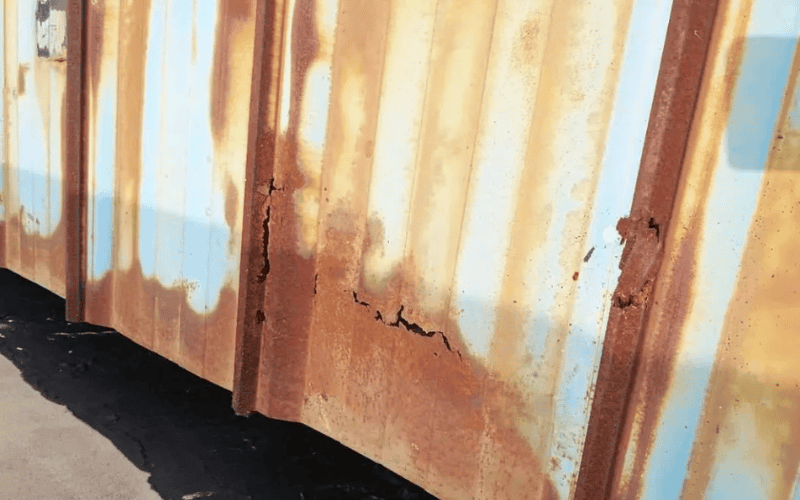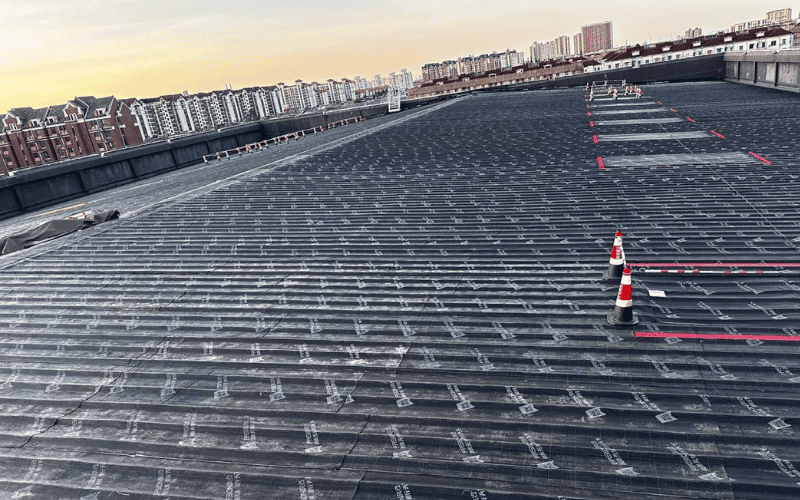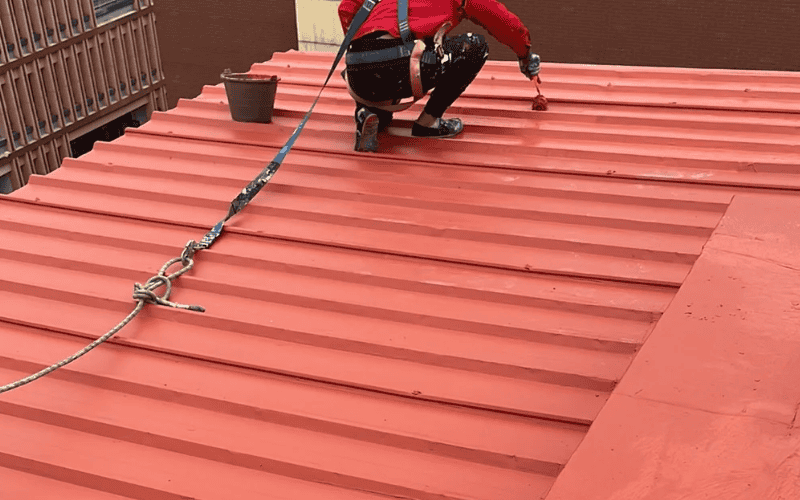If your metal roof is leaking, you might be struggling with how to fix it. There are many potential causes for leaks. Fortunately, there are several effective solutions available. In this article, we will provide you with 6 common repair methods + 6 possible ones to help resolve your metal roof leaks. The common methods include:
- Repair or Replace Screws and Fasteners
- Replace Stack Flashing and Pipe Seals
- Update Sealant Materials
- Apply Roof Coating
- Use Spray Foam Repair
- Replace Roof Seams and Overlaps
And the possible ones are:
- Re-Caulking Around Roof Penetrations
- Inspect and Replace Rusted or Corroded Areas
- Improve Roof Ventilation
- Add or Replace Gutter Systems
- Roof Flashing Repair or Replacement
- Fixing Roof Valleys
If you already know which method is best for your situation, you can skip the detailed explanation and directly choose the appropriate solution. If you’d like to learn more details, continue reading.

Common Solutions to Metal Roof Leaks
Solution 1: Repair or Replace Screws and Fasteners
Applicable Scenario – Leaks concentrated around screws or fasteners.
Problem Analysis
Loose or improperly installed screws are one of the most common causes of metal roof leaks. If screws are over-tightened or not tightened enough, the seal can fail, leading to water leaks.
Repair Method
- Inspect all screws for damage or looseness. Tighten any loose screws.
- Use the appropriate tools to reinstall or replace damaged screws.
- Ensure the new screws are securely fastening the metal panels, and check that the seal rings are intact.
Solution 2: Replace Stack Flashing and Pipe Seals
Applicable Scenario – Leaks occurring around pipes or vents.
Problem Analysis
Stack flashing (used for pipe and vent seals) is a common leak point on metal roofs, especially after multiple seasonal changes. The sealing materials may degrade, crack, or peel off, allowing water to enter.
Repair Method
- Inspect the seals around pipes and vents.
- Clean any old sealant materials and ensure the area is free from debris.
- Reinstall new sealing gaskets or rubber flashing to prevent water ingress.
Solution 3: Update Sealant Materials
Applicable Scenario – Sealant around seams or ridges degraded or peeled off.
Problem Analysis
Over time, sealant materials around roof seams and ridges degrade, especially in cold or humid climates, leading to water infiltration.
Repair Method
- Regularly inspect the seams, ridges, and flashing areas of the roof for signs of sealant degradation.
- Replace aged sealants with specialized metal roof sealants, such as acrylic or silicone-based products.
- Ensure new sealant fully covers all areas showing signs of degradation.
Solution 4: Apply Roof Coating
Applicable Scenario – Best for roofs with multiple small cracks or aging issues.
Problem Analysis
Roof coating is an affordable and effective solution for aging roofs, especially when small leaks or cracks are present. It not only repairs minor cracks but also enhances the roof’s waterproofing and extends its lifespan.
Repair Method
- Thoroughly clean the roof surface, removing all dirt and loose materials.
- Choose an appropriate coating material (such as silicone or acrylic-based coatings).
- Apply the coating evenly, ensuring all leak-prone areas are covered. The thickness and quality of the coating will determine its durability, with thicker coatings offering longer warranties.
Solution 5: Use Spray Foam Repair
Applicable Scenario – Best for roofs with concentrated leaks or significant localized damage.
Problem Analysis
Spray foam is a highly effective repair method for covering existing roofs and filling small cracks and holes, especially in areas where water penetration is more concentrated. It can also improve the roof’s insulation.
Repair Method
- Inspect the roof thoroughly to assess if spray foam can be applied directly.
- Clean the roof surface to ensure the foam adheres properly.
- After repairing any severely damaged areas, apply spray foam to seal the roof and prevent further leaks.
Solution 6: Replace Roof Seams and Overlaps
Applicable Scenario – Leaks occurring at roof seams or overlaps.
Problem Analysis
The seams and overlaps of metal roofs are common paths for water penetration. Over time, the sealant may degrade, causing leaks along these areas.
Repair Method
- Inspect the roof seams and overlaps to assess the risk of leaks.
- Reinstall new sealing materials or tape if the existing sealant is no longer effective.
- Use reinforcing materials such as metal strips to strengthen the seals and prevent future leaks.
Other Possible Metal Roof Leak Repair Methods

Apart from the common repair methods mentioned above, metal roof leaks can also be fixed through the following additional measures:
Solution 7: Re-Caulking Around Roof Penetrations
Applicable Scenario – Leaks specifically occurring around vents, pipes, or chimneys.
Problem Analysis
Leaks often occur around roof penetrations such as vents, chimneys, or skylights. The caulking or sealant around these areas can degrade over time due to weather exposure, leading to water ingress.
Repair Method
- Inspect all roof penetrations for signs of cracked or worn caulk.
- Remove the old caulk carefully and clean the surface before reapplying.
- Apply a high-quality silicone or polyurethane sealant to the seams and edges around the penetrations.
Solution 8: Inspect and Replace Rusted or Corroded Areas
Applicable Scenario – Necessary if you have a metal roof that has been exposed to elements for an extended period, especially in areas with high moisture or salt exposure.
Problem Analysis
Rust or corrosion on metal roofs, especially at joints or fastener points, can create holes or weak spots where water can penetrate. Corrosion is a particularly common issue in coastal areas with high humidity or salty air.
Repair Method
- Inspect the roof for any rusted or corroded areas, especially near seams, joints, and around screws.
- Sand the rusted areas to remove any loose corrosion.
- Apply a rust inhibitor or primer and then repaint with a high-quality roof paint or coating to prevent further rusting.
Solution 9: Improve Roof Ventilation
Applicable Scenario – If you’ve noticed signs of excess moisture or condensation in the attic, or if your roof is prone to mold and mildew growth.
Problem Analysis
Inadequate roof ventilation can cause moisture buildup within the attic, leading to condensation and water damage over time. Poor ventilation can also accelerate the degradation of roofing materials, potentially contributing to leaks.
Repair Method
- Install or repair roof vents to ensure proper airflow and reduce moisture buildup.
- Check for blockages in existing vents and clear them to maintain optimal ventilation.
Solution 10: Add or Replace Gutter Systems
Applicable Scenario – If your roof leaks are linked to poor water drainage from the gutters or downspouts.
Problem Analysis
Clogged, misaligned, or damaged gutters can cause water to back up and overflow, leading to leaks in the roof structure. Water that doesn’t properly drain away from the roof can seep into the attic or exterior walls, causing leaks.
Repair Method
- Inspect the gutters for any blockages, cracks, or misalignments.
- Clean the gutters and downspouts to ensure proper water flow.
- Replace damaged or ineffective gutters with larger or more efficient systems if necessary.
Solution 11: Roof Flashing Repair or Replacement
Applicable Scenario – If you’re noticing leaks at roof valleys, around chimneys, skylights, or any other roof penetration.
Problem Analysis
Flashing is used around roof penetrations, valleys, and chimneys to direct water flow and prevent leaks. Over time, flashing can corrode, warp, or become loose, resulting in water seeping into the roof structure.
Repair Method
- Inspect the flashing around all penetrations and valleys for any damage or gaps.
- Tighten loose flashing or replace damaged sections with new, corrosion-resistant materials.
Solution 12: Fixing Roof Valleys
Applicable Scenario – If you’ve identified leaks at or around roof valleys, where water may pool and lead to potential damage.
Problem Analysis
Roof valleys are where two sections of the roof meet, and they can become a weak point if not properly sealed or maintained. Water from rain or snow can accumulate in valleys and cause leaks if they are not adequately protected.
Repair Method
- Inspect the valleys to see if there’s accumulated debris or damage to the flashing.
- Remove debris and re-seal any gaps in the flashing or roof material to improve water flow through the valley.

Conclusion
Based on the condition of your roof and your budget, choose the most suitable repair method. If you have localized leaks, applying a coating or using spray foam may be the best option. For more widespread leaks, you may need to replace screws, repair seams, or replace the roof.
To prevent small issues from turning into major leaks, it’s recommended to regularly inspect your roof and sealing materials. Timely identification and repair of potential problems will greatly extend the lifespan of your roof. By choosing the right repair method and maintaining regular upkeep, your metal roof will continue to protect your home from the elements.
What You Might Also Want to Ask
1. Is it common for metal roofs to leak?
Metal roofs are generally durable, but leaks can occur due to poor installation, damaged seals, or aging materials.
2. How do you find the source of a leak in a metal roof?
Inspect the roof for visible damage around seams, flashing, and fasteners. Look for rust, cracks, or deteriorated sealants.
3. Why does my metal roof leak in heavy rain?
Leaks during heavy rain are often caused by inadequate sealing around roof penetrations, seams, or worn-out flashing.
4. Do metal roofs leak at the screws?
Yes, if screws are not properly installed, sealed, or if the seals around them degrade, leaks can occur.
5. Do metal roofs leak more than shingles?
Metal roofs generally leak less than shingles, but leaks can occur if they are not properly maintained or installed.
6. What is the permanent solution for roof leakage?
A permanent solution involves repairing the damaged areas, replacing sealants, or even replacing sections of the roof if necessary.
7. How long can you leave a leaking roof?
It’s best to address a leaking roof immediately to prevent structural damage or mold growth. Delaying repairs can lead to more severe issues.
8. What is the best thing to stop a roof from leaking?
Regular maintenance, sealing damaged areas, and replacing worn-out materials are the most effective ways to prevent leaks.
9. Will painting a metal roof stop leaks?
Painting a metal roof can help with minor leaks and corrosion, but it’s not a permanent solution for major leaks. Proper repairs are necessary.

